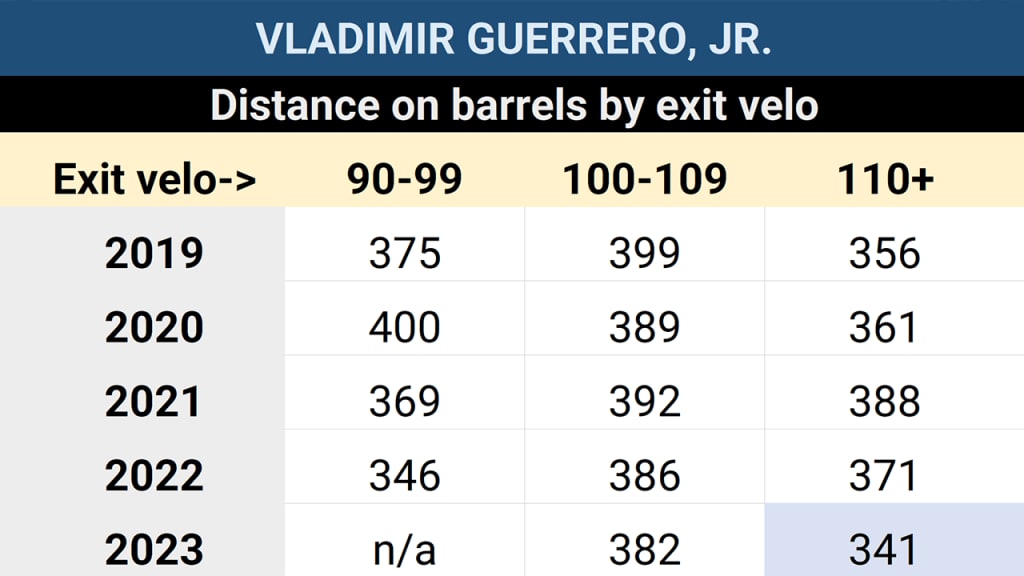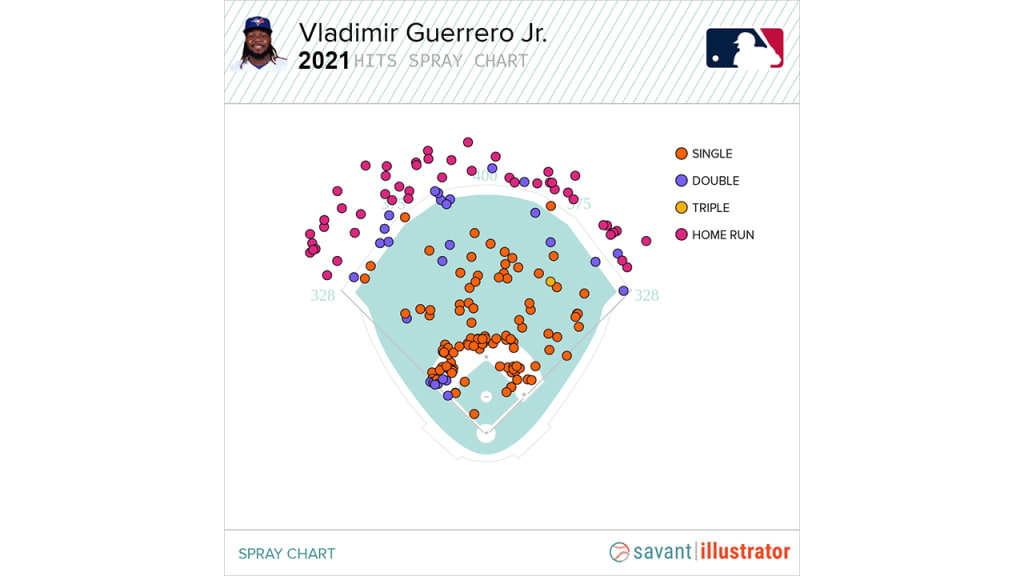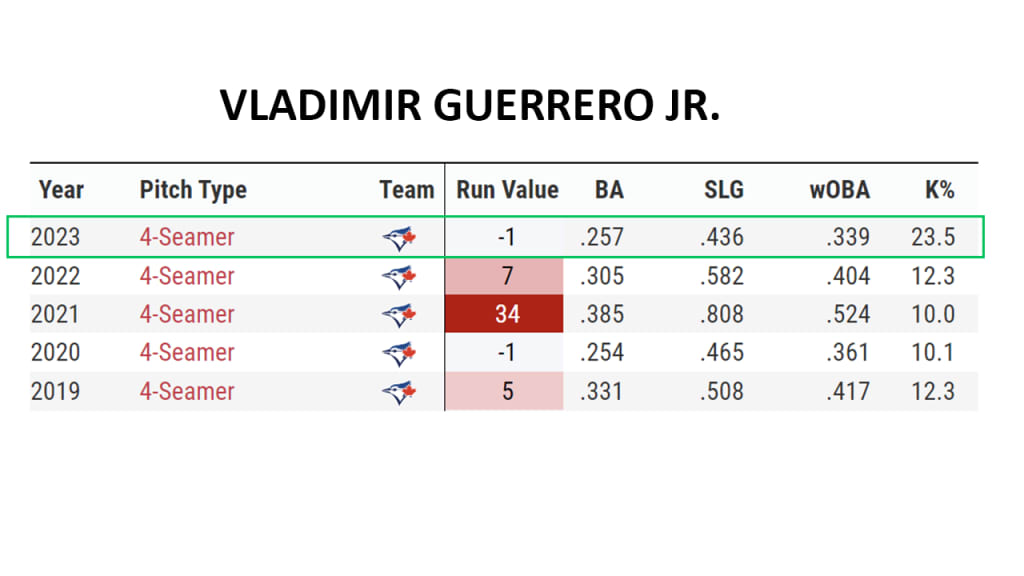To say that Vladimir Guerrero Jr. has had an underwhelming season is, itself, an underwhelming statement.
Guerrero’s 116 OPS+ isn’t bad, exactly; it’s 16 percent better than the Major League average. But it’s hardly what would be expected from a player who just two years ago, at 22, mashed 48 homers and looked for all the world like he’d be spending the next decade-plus laying waste to any pitcher foolish enough to challenge him in the zone.
Worse, because he’s a below-average runner and fielder – another area that’s taken a step back this year – the just-OK bat has contributed to a not-OK season. One version of WAR has him at 0.4, the other says 1.1, but ultimately, it doesn’t matter which is “right.” Neither is great. Neither is even good. It’s a big part of why the Jays hold just the third Wild Card spot, and only barely that.
Yet most confounding about Guerrero’s season is this: He’s not striking out more than he did in his magical 2021 (his strikeout rate is a similar 15% in each season). He’s not putting the ball on the ground too much, as he has at times in the past (his ground ball rate of 47% isn’t 2021’s 45%, but it is the second-lowest of his career). And he’s not, by any means at all, failing to hit it hard. If anything, it’s the opposite: His hard-hit rate is in the 96th percentile, and only Ronald Acuña Jr. has more hard-hit balls overall. In June, he actually had the second-best hard-hit month of his career.
Everything says that this is a player who should be excelling, but it’s just not happening. So what’s wrong? How does a player this young (notable 2023 rookies he’s younger than include James Outman, Josh Jung, and Spencer Steer) with this recent history of success and without any of the obvious hitting red flags you’d look for struggle this much?
There’s no shortage of theories, as you might expect. Blue Jays fans provided us with their best guesses. Let’s see which ones hold water.
Theory 1: It’s bad luck.
“Bad luck” is typically an easy first place to look, though it rarely holds up as well as you’d think. In this case, it’s not hard to see why it comes up for Guerrero. Statcast creates “expected” stats based on the quality of contact and how much contact is made, and basically no one in the game is under-performing by as much as Guerrero is.
His average is .265, but his expected average is .303; the gap of 38 points is the second largest. It’s the same for slugging (he’s got a .436, but the expected is .515, a top-5 gap), and for wOBA, a stat similar to OPS where he, again, has one of the largest gaps in the game.
Basically, what’s being said there is that while his quality of contact isn’t quite as good as it was in 2021, it’s not all that far off, either. Yet the results are not.
But what does “bad luck” mean? Sometimes, it means getting robbed by great plays, though that doesn’t seem to be the case here. He’s hit just one non-homer ball that would have been out of at least 20 other parks. Instead, the reason that Guerrero isn’t finding the success you’d think is that all of the expected stats are based on quality of contact (based on how hard you hit it, at this angle, this outcome usually happens, etc.) and for him, something is happening between that great contact and uninspiring outcome – and it might not be luck.
Instead, it’s …
Theory 2: He’s not hitting the ball as far as you’d think given how hard he’s hitting it.
… this oddity.
When he barrels the ball up – a barrel being the perfect combination of exit velocity and launch angle, which in the Majors in 2023 leads to a .737 average and 2.467 slugging, i.e. “really incredible production" – he’s hitting those crushed baseballs an average of 365 feet. It’s well below the MLB average of 385 feet; it’s the second-shortest of hundreds of players who have at least 10 such batted balls; it’s by far the shortest of his career.
It’s something without a clear explanation, though it's particularly afflicting him on the hardest-hit balls. When he hits barrels 110 mph or harder -- elite, obviously, exit velocity -- he's down an astounding 47 feet from 2021.

That's a lot of homers that become singles, or outs, and sometimes it feels like you can even see the ball just bending downwards. It feels like sometimes he's hitting the ball so hard that topspin is dragging it down, though there's not data to confirm or refute that currently.
While it’s popular to say that he’s not pulling the ball in the air enough, which we’ll get to in a second, that seems to be an oversimplification, because he’s A) pulling those high-value barrels more than he did in 2021, and B) getting less distance on his pulled barrels (352 feet) than he is towards center field (379 feet) or opposite field (358 feet). He’s lost dozens of feet of distance just on pulled barrels, which makes it hard to say “do that more.”
This is one way to underperform those expected stats beyond “bad luck,” because in theory he’s the one making this happen. But how? Why is this happening?
Theory 3: He’s pulling it too much, or not enough, or not exactly the right amount.
This one came up a lot, mostly in association with complaints about hitting coaches – as though Guillermo Martinez wasn’t also the coach in 2021 when Guerrero shined (he was) or that Martinez wasn’t still the coach last year and this year when Bo Bichette came out of a long rut in 2022 to shine late and into this season (he was, and is).
The Jays have the fourth-lowest pull rate, which sounds bad, but there’s not a great relationship between that and success; two of the teams below them are weak offenses (Cleveland, Miami), yet also there’s the high-scoring Rangers. Oakland has the third-highest pull rate, which tells you something. What matters is pulling the ball in the air – this is where success is – yet the Jays have the ninth-most such balls this year.
Guerrero’s pull rate is down slightly, but on balls in the air, he is pulling 27% of them, down massively from 2021’s … 28%. Besides, at his best, Guerrero is such a strong all-fields hitter that he’s never needed to sell out for power in this way. Just look at what his 2021 spray chart looked like.

It’s probably not this, at least not as much as people want it to be. It’s more about what happens when he does pull than about how often it happens.
Theory 4: He was only ever good in Minor League parks.
That wonderful 2021, remember, came when the Blue Jays split their season between Dunedin, Buffalo, and finally Toronto. Guerrero torched Dunedin (11 homers and a 1.418 OPS in 21 games), and he crushed Buffalo (10 homers and a 1.180 OPS in 23 games).
If the argument is that he abused Minor League parks and then didn’t maintain a pace that would have been 38 homers over a full home slate (or 76 homers over 162), then that is absolutely correct. The friendly parks likely fueled his final 2021 line above and beyond where it might have otherwise been. (If, of course, we ignore the massive disruption to the lives of players and their families, which no other club had to the same extent.)
But that still underrates how good he was that year, and likely overstates what’s happening in 2023. In Toronto two years ago, he had an excellent .926 OPS, which is 244 points higher than he has in Canada this year – a fact which has little to do with Minor League parks. (If he had a .926 OPS in Toronto this year, there would be no problems.) On the road in 2021 before they returned to Toronto, he had a .909 OPS. Maybe the lower-level parks helped a little, but they don't come close to explaining 2023.
Instead, we can point out two things about that time. First, it wasn’t just the small distances or warm weather. In Dunedin, it was the absolute mashing of baseballs -- his home field quality of contact during that stretch was by far the best in the sport. In Buffalo, and in Toronto, the quality of contact was identical, and each more “extremely good” than “out-of-this-world elite.”
But in Buffalo, he overperformed by nearly 60 points of weighted on-base, which is a lot, though many other hitters did so by more during that span. Yet in 2021 in Toronto, he underperformed by nearly 40 points, which is hardly out of line with what anyone else did in that span.
Which leads us into our next theory …
Theory 5: He dislikes the new Rogers Centre dimensions.
This might be nothing, but it’s at least worth noting how odd this is. Rogers Centre had always leaned towards the hitter-friendly side of things, but last winter’s renovations were expected to be neutral at worst and very possibly add some homers.
Instead, Guerrero didn’t hit his first home run at home until June 23. His season splits look like this.
- Home: .232/.327/.356, .682 OPS, 5 HR
- Road: .294/.356/.506, .862 OPS, 13 HR
A .682 OPS is unacceptable for a bat-first player like Guerrero; it is essentially light-hitting Chicago outfielder Andrew Benintendi. But an .862 OPS? That’s Austin Riley, or J.D. Martinez. Road Vlad isn’t quite the 2021 version, but if Home Vlad was hitting like Road Vlad is, Blue Jays fans wouldn’t be nearly so frustrated.
So what’s happening here? There’s little difference in hard-hit rate or strikeout rate. The swing and chase rates are identical. The quality of contact is a little better on the road than home, but not by much. There’s some BABIP difference, sure, but basically this comes down to the value of the eight home runs – which is at least a little related to the fact that he really is elevating and pulling more away from Canada.
It might also just be a partial-season fluke. It’s hardly afflicting the entire lineup – Alejandro Kirk, George Springer, and Kevin Kiermaier have all been better at home than away – and it’s not even a notably large home/road split in the context of the Majors this year. (Aaron Judge, incredibly, has the largest “better on the road” split.) Plus, before this season, Guerrero slugged an identical .474 both at home (Toronto only) and on the road. It’s something to keep an eye on. It might not be more than that.
Theory 6: It’s lack of protection.
This came up enough that we’ll at least address it, but: It’s not this. In 2021, Guerrero mostly hit ahead of Teoscar Hernandez or Bo Bichette. In 2022, the lineup was in enough flux that he didn’t have a “regular” hitter behind him, with Kirk filling the role more than anyone. This year has been similar: He’s variously hit ahead of Matt Chapman, Daulton Varsho, Brandon Belt and Springer, who have each been variously hot or cold at different times.
Aside from the fact that many studies have been done over the years that suggest that lineup protection doesn’t manifest in the way tradition would have you believe – mostly because if the point is to not walk a lesser hitter ahead of a good hitter, why pitch to the lesser hitter in a way that makes him a better hitter? – the specifics of this case don’t match up. Guerrero isn’t seeing fewer pitches in the zone than in 2021; he’s seeing more. It doesn’t address the weird home/road split, or the gap between his actual and expected contact. Besides, Chapman, Belt and Springer are established veterans behind him who are hardly Minor League fill-ins.
It’s almost certainly not this. It’s never this.
Theory 7: He’s injured or not in peak condition.
In March, Guerrero injured his right knee, which was enough to force him to withdraw from the World Baseball Classic, but not enough to prevent him from getting off to a long-forgotten outstanding start, hitting .318/.389/.530 through May 5. He was then a late scratch with left wrist discomfort, and didn’t play again until May 9. Ever since, he’s hit only .244/.322/.398.
Compelling! And yet: A potential lingering injury didn’t prevent him from winning the 2023 T-Mobile Home Run Derby in July. It hasn’t stopped all those hard-hit numbers from piling up. It hasn’t stopped him from hitting better on the road since then. We couldn’t possibly rule on this with certainty one way or another, but it’s not more than circumstantial at this point.
It’s worth noting, though, that Guerrero’s sprint speed has dropped from the 45th percentile in 2021 to the 26th this year, with a decline in his defensive metrics as well. Not that speed ever is or was his game, but leading into 2021, Guerrero was quite open about the work he’d put into conditioning, in an attempt to make his swing more repeatable. “When he was fatigued,” Guillermo Martinez had said in 2020, “it caused him to search for more power, which caused him to jump at the baseball.” Speed might be a proxy, in this case.
Theory 8: He’s behind on the fastball.
It’s difficult to investigate all this and not realize what’s happened on four-seam fastballs.

There might be something to this. In 2023, he’s taking the four-seamer to the opposite field more than ever, when 2021 it was the least ever. In 2023, he’s pulling four-seamers just 17% of the time, a career low, and by a lot, especially when you consider that in the big year two years ago, it was 30%. He’s also swinging and missing a lot more against four-seamers, too.
There’s a little more movement towards him on those four-seamers, and when he does pull those fastballs, he’s down more than 200 points of slugging. But perhaps most concerning is what happens on the edges of the zone, an area where he’s taken a huge step back since 2021. That year, he had eight homers on four-seamers on the edges. This year: He’s got eight hits.
It's incredibly difficult to know if this is about approach, any lingering wrist issue, or anything else. But it's at the heart of the problem.
Theory 9: He’s not adjusting to changing pitches or his approach is poor.
It’s not just fastballs, though. He's down considerably on sliders, too, which can't be a coincidence.
“I just think it comes down to location,” Toronto manager John Schneider said on MLB Network Radio’s “Power Alley” this week. “It’s pretty apparent how teams are attacking him with fastballs in and especially down in the zone. Part of it comes down to pitch selection, and timing. When he gets it in the location he can really hammer it, that’s when we see the results we’re accustomed to.”
Guerrero is swinging more, a career high 52%, up from his usual 48%. He’s chasing a lot more than he did in 2021 (up from 24% to 30% is a big deal; that’s above-average to below-average) but not more than he did in 2022. On the other hand, he’s a lot more aggressive on the first pitch … right back to where he was in 2021.
His slugging in the zone is similar to what it was last year. His slugging on the edges and beyond is a career-low .283.
Theory 10: He is who he is, and 2021 was just a fluke season.
It’s possible for a great hitter to have one all-time year that they never manage to repeat. Bryce Harper had that year, at 22 years old in 2015, when he hit 42 homers with a 198 OPS+, and while he’s had a run of good to very good years since – including 2021, when he won another MVP Award – he’s yet to have another 40-homer season or match that 2015 since.
Maybe that was what Vlad’s 2021 was -- it's indeed difficult to expect endless years that tremendous. But even so, that doesn't explain why his 2023 looks like this, and not like his solid-enough 2022 (when he had 32 homers with a 133 OPS+).
Theory 11: Maybe it’s all of it.
Setting aside our favorite remaining theory – that he misses the home run jacket that the club retired before this season – the incredibly frustrating answer seems to be that there isn’t an answer, or, if we choose to be optimistic, that something like better pitch selection and getting your timing back doesn't seem to be something insurmountable.
In some ways, this would be easier to accept if he were clearly injured, or if he couldn't make contact, or couldn't make good contact. None of that seems to be the case. Guerrero Jr. is, in some ways, a victim of the high bar he has set for himself. The good news, at least, is that the core talent still seems to exist. There's a better version of Vlad Jr. still in there, the one all Jays fans are waiting on. He is after all, still only 24 years old.
